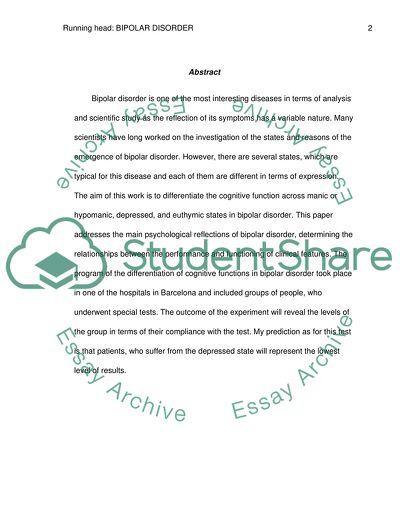Cite this document
(Differentiating the Cognitive Function Across Manic or Hypomanic in Bipolar Disorder Research Proposal Example | Topics and Well Written Essays - 2500 words, n.d.)
Differentiating the Cognitive Function Across Manic or Hypomanic in Bipolar Disorder Research Proposal Example | Topics and Well Written Essays - 2500 words. https://studentshare.org/psychology/1854515-diferentiating-the-cognitive-function-across-manic-or-hypomanic-depressed-and-euthymic-states-in-bipolar-disorder
Differentiating the Cognitive Function Across Manic or Hypomanic in Bipolar Disorder Research Proposal Example | Topics and Well Written Essays - 2500 words. https://studentshare.org/psychology/1854515-diferentiating-the-cognitive-function-across-manic-or-hypomanic-depressed-and-euthymic-states-in-bipolar-disorder
(Differentiating the Cognitive Function Across Manic or Hypomanic in Bipolar Disorder Research Proposal Example | Topics and Well Written Essays - 2500 Words)
Differentiating the Cognitive Function Across Manic or Hypomanic in Bipolar Disorder Research Proposal Example | Topics and Well Written Essays - 2500 Words. https://studentshare.org/psychology/1854515-diferentiating-the-cognitive-function-across-manic-or-hypomanic-depressed-and-euthymic-states-in-bipolar-disorder.
Differentiating the Cognitive Function Across Manic or Hypomanic in Bipolar Disorder Research Proposal Example | Topics and Well Written Essays - 2500 Words. https://studentshare.org/psychology/1854515-diferentiating-the-cognitive-function-across-manic-or-hypomanic-depressed-and-euthymic-states-in-bipolar-disorder.
“Differentiating the Cognitive Function Across Manic or Hypomanic in Bipolar Disorder Research Proposal Example | Topics and Well Written Essays - 2500 Words”. https://studentshare.org/psychology/1854515-diferentiating-the-cognitive-function-across-manic-or-hypomanic-depressed-and-euthymic-states-in-bipolar-disorder.


